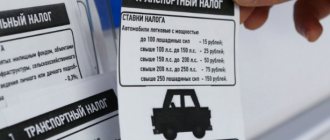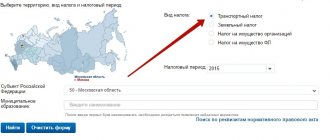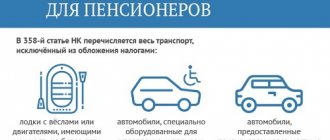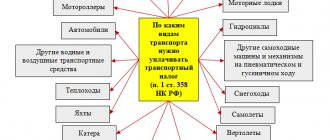Tax Code >> Chapter 28
Article 356 General provisions
Article 357 Taxpayers
Article 358 Object of taxation
Article 359 Tax base
Article 360 Tax period. Reporting period
Article 361 Tax rates
Article 361.1 Tax benefits
Article 362 Procedure for calculating the amount of tax and amounts of advance payments for tax
Article 363 Procedure and terms for payment of tax and advance payments of tax
Article 363.1 Tax return
Chapter 28 of the Tax Code of the Russian Federation Transport tax
| Chapter 27 | Chapter 29 |
Comments on Chapter 28 of the Tax Code of the Russian Federation - Transport tax
Transport tax
Vehicle tax is a mandatory component of the tax base of all civilized countries. This payment relates to regional taxes and fees, the amount of which is set separately in each region. The competence of regional authorities also includes the adoption of resolutions establishing transport tax benefits. In the Tax Code of the Russian Federation, transport tax is described in Chapter 28, which regulates all the main provisions of this type of taxation.
Transport tax rates are set taking into account the technical characteristics of taxable objects, which include cars, buses, special equipment, motorcycles, scooters, yachts, and boats. At the same time, the period during which the vehicle is owned by the person paying this fee is taken into account.
The Tax Code of the Russian Federation defines the following important points regarding transport tax:
- objects of taxation;
- length of the tax period;
- method of calculating transport tax;
- preferential categories of citizens and vehicles
According to current legislation, the 2017 transport tax continues to be calculated using regional rates.
Object of taxation, tax base of transport tax
In Art. 358 of the Tax Code of the Russian Federation discloses the concept of an object for collecting transport tax, this is:
- cars (except for low-power cars equipped for disabled people);
- motorcycles and scooters;
- buses;
- self-propelled types of transport, including caterpillar ones;
- air transport;
- water transport;
- motor sleighs and snowmobiles.
Transport that is not recognized as an object of taxation is listed in paragraph 2 of Art. 358 of the Tax Code of the Russian Federation, incl. This:
- rowing boats and motorboats with an engine of no more than 5 hp,
- special vehicles for disabled people, and cars up to 100 hp, purchased through Social Security authorities,
- fishing vessels (river, sea),
- transport of agricultural producers used by them for the production of agricultural products (tractors, combines, milk tankers, etc.),
- air transport for medical and medical services,
- stolen vehicle,
- other types of transport listed in the list of paragraph 2 of Art. 358 Tax Code of the Russian Federation.
Read also: Vehicle codes
To recognize a vehicle (vehicle) as an object of taxation, it is necessary that this asset be registered in the territory of the Russian Federation. The tax base for transport tax is determined according to the provisions of Art. 359 of the Tax Code of the Russian Federation. It can be calculated according to several parameters:
- for vehicles with engines, the reference point is engine power, expressed in horsepower;
- For air transport, one must rely on the thrust of a jet engine;
- for water transport that cannot move under its own power, but only by towing, the gross tonnage indicated in registered tons is taken into account for taxation;
- for other water and air vehicles, the vehicle unit is taken as the basis for calculations.
The tax base for transport tax is calculated separately for each object. The parameters required to calculate the tax amount are taken from the registration and technical documentation for the vehicle (date of registration or date of deregistration, power or other indicator by which the tax base is identified). For business entities paying advance payments for this tax, the final amount of the calculation at the end of the year must be calculated as the difference between the annual amount of obligations and payments made in the period under review.
To determine the amount of tax payable, the tax base of the transport tax is multiplied with the tax rate for a specific category of transport. For some vehicles, increasing coefficients are provided, which are also multiplied by the tax base.
If in the accounting year the vehicle was owned for less than 12 months, it is necessary to add to the formula the “ownership coefficient” - the actual number of months of ownership divided by 12. If the vehicle was registered after the 15th day of the month, this month is not counted if before the 15th dates (inclusive) – the month is taken as a full month. Accordingly, if a vehicle is deregistered after the 15th, this month will be counted, but if it is on the 15th or earlier, it will not be taken into account in the tax calculation.
Read also: How to calculate car tax – 2018
Rates and deadlines for payment of transport tax
The main indicators used in calculating vehicle tax are the regional rate, horsepower and the period of ownership of the vehicle. The formula for calculating this payment is the product of the following parameters:
- regional flat rate
- the number of horsepower indicated in the technical passport of the vehicle;
- number of months of ownership divided by 12
For elite class vehicles, the cost of which exceeds 3 million rubles, in most cases increasing coefficients are applied. Transport tax is paid by all owners of registered vehicles, regardless of whether the vehicle is in use, undergoing long-term repairs, or is simply parked in a garage.
Article 358. Object of taxation
1. The objects of taxation are cars, motorcycles, scooters, buses and other self-propelled machines and mechanisms on pneumatic and caterpillar tracks, airplanes, helicopters, motor ships, yachts, sailing ships, boats, snowmobiles, motor sleighs, motor boats, jet skis, non-self-propelled (towed vessels) and other water and air vehicles (hereinafter in this chapter - vehicles) registered in the prescribed manner in accordance with the legislation of the Russian Federation.
2. The following are not subject to taxation:
1) rowing boats, as well as motor boats with an engine power not exceeding 5 horsepower;
2) passenger cars specially equipped for use by disabled people, as well as passenger cars with an engine power of up to 100 horsepower (up to 73.55 kW), received (purchased) through social welfare authorities in the manner prescribed by law;
3) fishing sea and river vessels;
4) passenger and cargo sea, river and aircraft owned (by the right of economic management or operational management) of organizations and individual entrepreneurs whose main activity is passenger and (or) cargo transportation;
5) tractors, self-propelled combines of all brands, special vehicles (milk tankers, livestock trucks, special vehicles for transporting poultry, machines for transporting and applying mineral fertilizers, veterinary care, maintenance), registered to agricultural producers and used in agricultural work for the production of agricultural products ;
6) vehicles owned by the right of operational management to federal executive authorities, where military and (or) equivalent service is legally provided for;
7) vehicles that are wanted, subject to confirmation of the fact of their theft (theft) by a document issued by the authorized body;
 airplanes and helicopters of air ambulance and medical services;
airplanes and helicopters of air ambulance and medical services;
9) ships registered in the Russian International Register of Ships;
10) offshore fixed and floating platforms, offshore mobile drilling rigs and drilling ships.
Features of the transport tax benefit
Payment of transport tax is not provided for owners of motor boats with engines whose power is less than 5 hp, and vehicles equipped for the disabled. Other preferential categories of citizens and transport are listed in Art. 361.1. Tax Code of the Russian Federation "Transport Tax". To receive a transport tax benefit, a citizen must submit an application with supporting documents to the relevant tax authority.
The tax period for payment of transport tax is a calendar year. For enterprises that own vehicles, the tax periods include the first, second and third quarter. A notice of payment of transport tax must be sent to the taxpayer no later than 30 days before the end of the payment deadline.
Transport tax base rate
Basic tax rates are fixed by the Tax Code, but regional authorities are vested with the authority to change these tariffs. When adjusting tax rates, upper limit limits are provided - the basic rate can be increased, but not more than 10 times.
The rates fixed in the Tax Code of the Russian Federation are presented in the table:
Transport tax rates (Article 361 of the Tax Code of the Russian Federation)
| Name of taxable object | Tax rate (in rubles) |
| Passenger cars with engine power (per horsepower): | |
| up to 100 hp (up to 73.55 kW) inclusive | 2,5 |
| over 100 hp up to 150 hp (over 73.55 kW to 110.33 kW) inclusive | 3,5 |
| over 150 hp up to 200 hp (over 110.33 kW to 147.1 kW) inclusive | 5 |
| over 200 hp up to 250 hp (over 147.1 kW to 183.9 kW) inclusive | 7,5 |
| over 250 hp (over 183.9 kW) | 15 |
| Motorcycles and scooters with engine power (per horsepower): | |
| up to 20 hp (up to 14.7 kW) inclusive | 1 |
| over 20 hp up to 35 hp (over 14.7 kW to 25.74 kW) inclusive | 2 |
| over 35 hp (over 25.74 kW) | 5 |
| Buses with engine power (per horsepower): | |
| up to 200 hp (up to 147.1 kW) inclusive | 5 |
| over 200 hp (over 147.1 kW) | 10 |
| Trucks with engine power (per horsepower): | |
| up to 100 hp (up to 73.55 kW) inclusive | 2,5 |
| over 100 hp up to 150 hp (over 73.55 kW to 110.33 kW) inclusive | 4 |
| over 150 hp up to 200 hp (over 110.33 kW to 147.1 kW) inclusive | 5 |
| over 200 hp up to 250 hp (over 147.1 kW to 183.9 kW) inclusive | 6,5 |
| over 250 hp (over 183.9 kW) | 8,5 |
| Other self-propelled vehicles, pneumatic and tracked machines and mechanisms (per horsepower) | 2,5 |
| Snowmobiles, motor sleighs with engine power (per horsepower): | |
| up to 50 hp (up to 36.77 kW) inclusive | 2,5 |
| over 50 hp (over 36.77 kW) | 5 |
| Boats, motor boats and other water vehicles with engine power (per horsepower): | |
| up to 100 hp (up to 73.55 kW) inclusive | 10 |
| over 100 hp (over 73.55 kW) | 20 |
| Yachts and other sailing-motor vessels with engine power (per horsepower): | |
| up to 100 hp (up to 73.55 kW) inclusive | 20 |
| over 100 hp (over 73.55 kW) | 40 |
| Jet skis with engine power (per horsepower): | |
| up to 100 hp (up to 73.55 kW) inclusive | 25 |
| over 100 hp (over 73.55 kW) | 50 |
| Non-self-propelled (towed) ships for which gross tonnage is determined (from each registered ton of gross tonnage) | 20 |
| Airplanes, helicopters and other aircraft with engines (per horsepower) | 25 |
| Airplanes with jet engines (per kilogram of thrust) | 20 |
| Other water and air vehicles without engines (per vehicle unit) | 200 |
How the authorities use transport tax
Many car owners are concerned about where the money transferred in the form of vehicle tax goes and how it is used. This important point is regulated by Articles 14 of the Tax Code of the Russian Federation and 56 of the Budget Code of the Russian Federation, which voice the following provisions. Transport tax is transferred to the general regional budget without any specific purpose. That is, regional authorities can spend this money on almost anything, from the construction of socially important facilities to the improvement of urban areas.
Until January 1, 2003, these fees went to the funds of the road services involved in the improvement of roads. However, the high corruption component and well-established kickback schemes forced the Government of the Russian Federation to introduce a regional tax on transport, which is paid to the regional budget without legislative control over its use.










